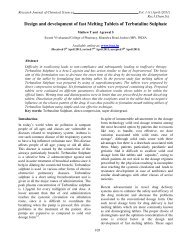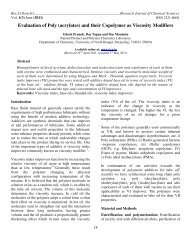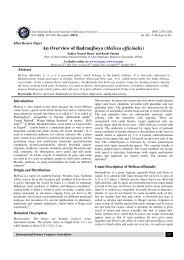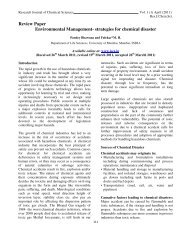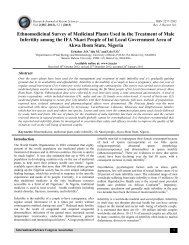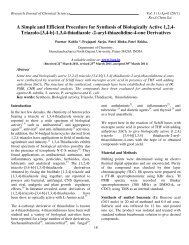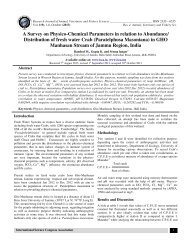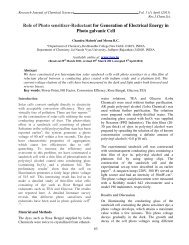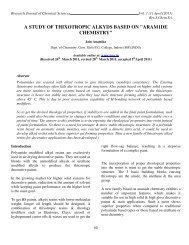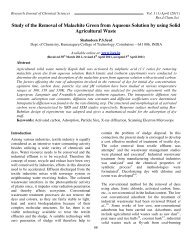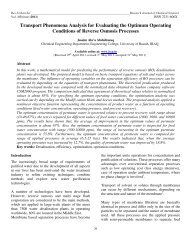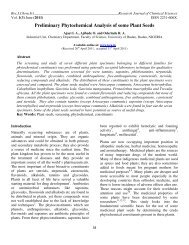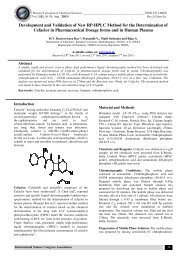Growth and Characterization of Chemical bath Deposited ... - ISCA
Growth and Characterization of Chemical bath Deposited ... - ISCA
Growth and Characterization of Chemical bath Deposited ... - ISCA
You also want an ePaper? Increase the reach of your titles
YUMPU automatically turns print PDFs into web optimized ePapers that Google loves.
Research Journal <strong>of</strong> <strong>Chemical</strong> Sciences _______________________________________________________ ISSN 2231-606X<br />
Vol. 1(5), 48-51, Aug. (2011)<br />
Res.J.Chem.Sci.<br />
Optical properties: The optical absorption measurements<br />
were recorded in the range <strong>of</strong> 2500–5000 nm at room<br />
temperature without considering losses due to scattering<br />
<strong>and</strong> transmission. The optical b<strong>and</strong>-gap <strong>and</strong> the nature <strong>of</strong><br />
optical transitions can be obtained in dependence <strong>of</strong><br />
absorption coefficient on photon energy. The absorption<br />
coefficient (α) <strong>and</strong> the incident photon energy (hν) is<br />
related by the following equation 17<br />
α h υ = A(h υ − E<br />
n<br />
)<br />
g<br />
(5)<br />
where α is absorption coefficient (cm −1 ), hν the photon<br />
energy (eV), A <strong>and</strong> n are constants. A is complex<br />
parameter, which depends on temperature, photon energy<br />
etc. The n values are 0.5, 1.5, 2, <strong>and</strong> 3 for allowed direct,<br />
forbidden direct, allowed indirect <strong>and</strong> forbidden indirect<br />
transitions, respectively, E g is the direct b<strong>and</strong> gap energy.<br />
The optical b<strong>and</strong>-gap <strong>of</strong> lead selenide film was estimated<br />
by plotting the variation <strong>of</strong> (αhν) 2 versus hν <strong>and</strong><br />
extrapolating the linear portion near the onset <strong>of</strong> absorption<br />
edge to the energy axis, which is plotted in figure 4. In the<br />
present case <strong>of</strong> PbSe thin film, the plot <strong>of</strong> (αhν) 2 vs. hν<br />
(figure 4) show a linear portion indicating that the relation<br />
in equation (5) holds good for PbSe film if n = 0.5. This<br />
means that the optical transitions in the case <strong>of</strong> PbSe films<br />
are direct transitions. The linear portions <strong>of</strong> the curves<br />
were extrapolated to get the optical b<strong>and</strong> gap (figure 4).<br />
The optical b<strong>and</strong> gap for PbSe thin film is found to be 0.33<br />
eV.<br />
Figure-4<br />
Variation <strong>of</strong> (αhν) 2 versus hν for PbSe thin film<br />
(αhν 2 x 10 10 (eV/cm) 2 )<br />
3.5<br />
3.0<br />
2.5<br />
2.0<br />
1.5<br />
1.0<br />
0.31 0.32 0.33 0.34 0.35 0.36<br />
hν (eV)<br />
Electrical resistivity studies: The electrical resistivity <strong>of</strong><br />
‘as-deposited’ PbSe thin film sample was measured in the<br />
temperature range 300-500 K using a st<strong>and</strong>ard DC two<br />
point probe method under dark. A plot <strong>of</strong> inverse absolute<br />
temperature versus log (resistivity) is shown in figure 5.<br />
From figure 5 it is seen that the variation indicates two<br />
distinct temperature zones with two characteristic regions.<br />
It is observed that resistivity decreases with increase in<br />
temperature which is the indication <strong>of</strong> typical<br />
semiconductor characteristics. The room temperature<br />
electrical resistivity is found to be 6.35 × 10 2 Ω-cm. The<br />
activation energy <strong>of</strong> the chemical <strong>bath</strong> deposited PbSe film<br />
is calculated using the electrical resistivity result which is<br />
shown in figure 5. The value <strong>of</strong> activation energy (E a ) was<br />
calculated by equation given by 18<br />
ρ ⎛ ⎞<br />
= ρ exp Ea<br />
o ⎜ ⎟<br />
⎝ kT ⎠<br />
where ρ <strong>and</strong> ρ o are electrical resistivity, k is Boltzmann<br />
constant <strong>and</strong> T is absolute temperature. The activation<br />
energy for low temperature region <strong>and</strong> high temperature<br />
region is found to be 0.204 eV <strong>and</strong> 0.312 eV respectively.<br />
Figure-5<br />
Variation <strong>of</strong> log (resistivity) vs 1/T for PbSe thin film<br />
Log (resistivity)<br />
3.0<br />
2.8<br />
2.6<br />
2.4<br />
2.2<br />
2.0<br />
1.8<br />
1.6<br />
Thermoelectric power (TEP) measurements: The<br />
thermoelectric power is the ratio <strong>of</strong> thermally generated<br />
voltage to the temperature difference in the semiconductor,<br />
which gives the information about charge carriers in the<br />
deposited material. In thermoelectric power measurements,<br />
the open circuit thermo-voltage generated by film sample<br />
when a temperature gradient is applied across a length <strong>of</strong> a<br />
sample is measured. The type <strong>of</strong> conductivity exhibited by<br />
chemical <strong>bath</strong> deposited PbS thin film is determined by<br />
thermoelectric power (TEP) measurement. The TEP<br />
depends on the location <strong>of</strong> Fermi energy level in the<br />
material <strong>and</strong> the type <strong>of</strong> scattering mechanism. These<br />
variations are found to be non-linear with n-type<br />
conduction. The non-linearity indicates non-degeneracy <strong>of</strong><br />
the material whose thermoelectric power is proportional to<br />
n th power <strong>of</strong> absolute temperature 18 . From the sign <strong>of</strong> the<br />
terminal connected towards hot end it can be deduced the<br />
sign <strong>of</strong> the predominant charge carriers. In our case the hot<br />
end is connected to the positive terminal, the film shows n-<br />
type conductivity. The vacancies <strong>and</strong> interstitials control<br />
the conductivity type, an excess <strong>of</strong> Pb causes n-type<br />
conductivity 19 .<br />
Conclusions<br />
1.8 2.0 2.2 2.4 2.6 2.8 3.0 3.2 3.4<br />
1000/T (K -1 )<br />
In summary, polycrystalline n-PbSe thin films have been<br />
synthesized by simple <strong>and</strong> economical chemical <strong>bath</strong><br />
deposition technique. The structural studies indicate that<br />
the film sample is nanocrystalline in nature with cubic<br />
structure. The optical b<strong>and</strong> gap <strong>of</strong> ‘as-deposited’ film was<br />
found to be 0.33 eV having direct b<strong>and</strong> type transitions.<br />
The temperature dependence <strong>of</strong> the dc conductivity<br />
suggests that there are two types <strong>of</strong> conduction channels<br />
that contribute to the conductivity. The TEP measurement<br />
showed n-type conductivity.<br />
International Science Congress Association 50



